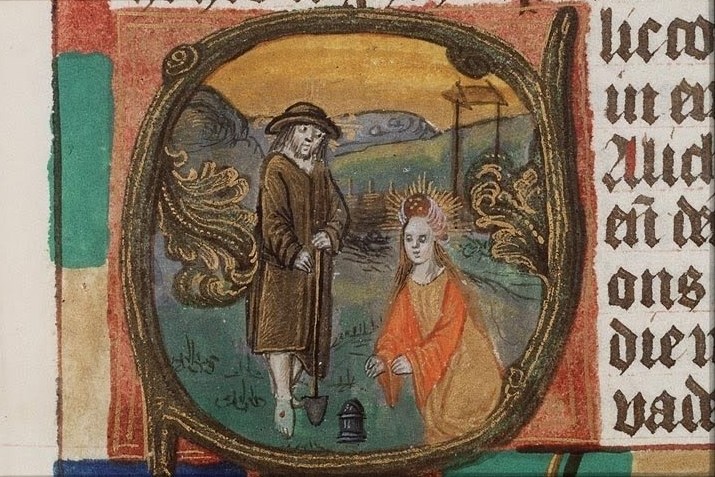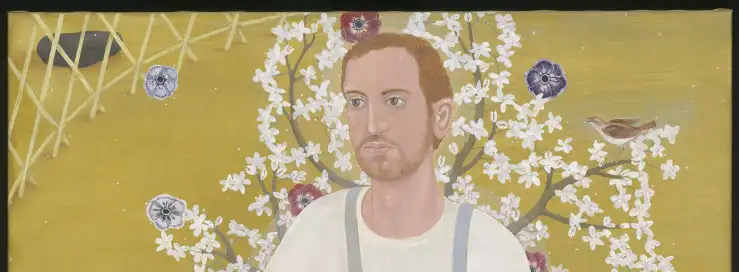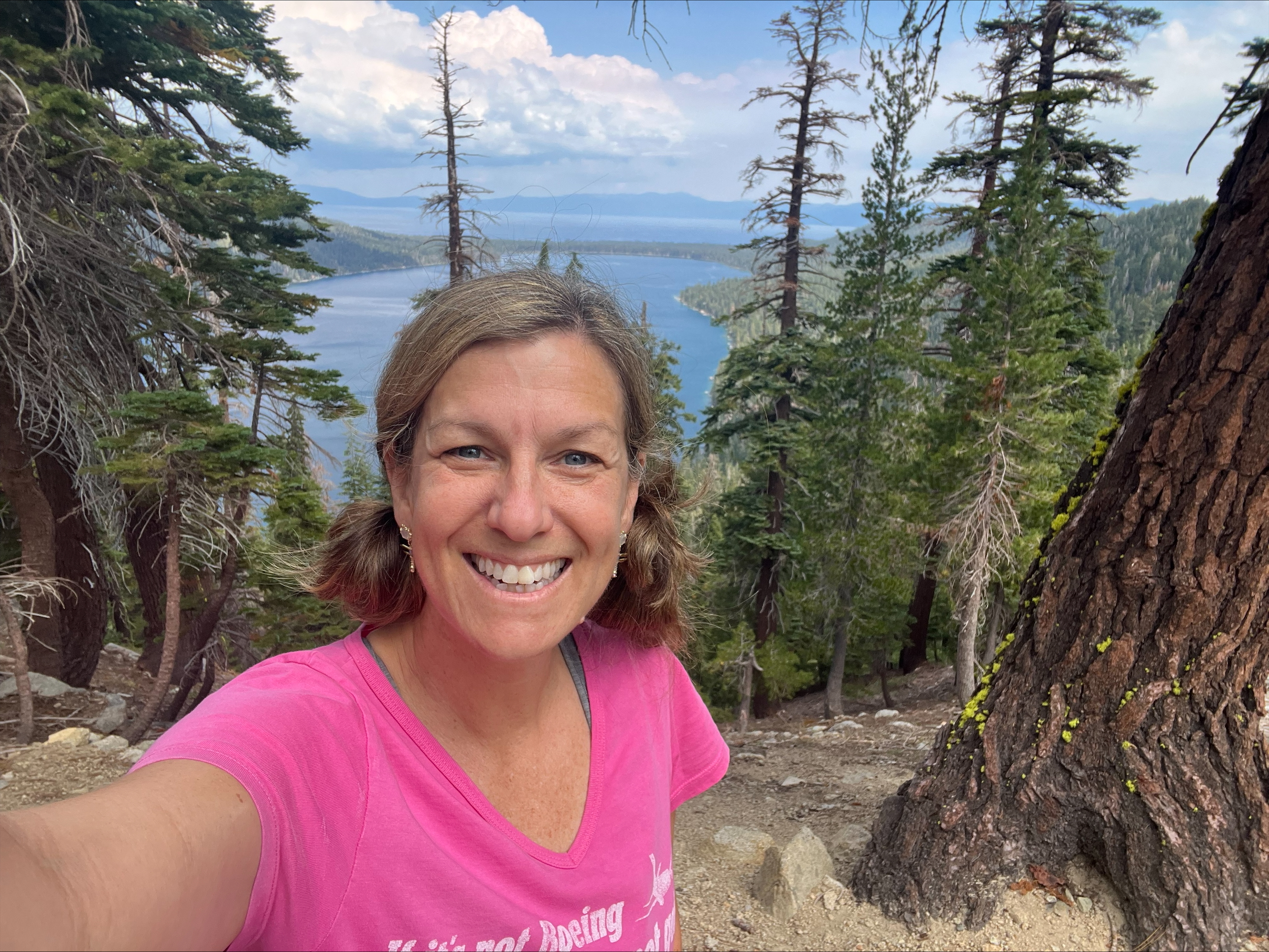The following is adapted from chapter 5 of Refugia Faith: Seeking Hidden Shelters, Ordinary Wonders, and the Healing of the Earth. Below, you will find an invitation to the Reformed Journal’s first Earth Month event on April 28. Please join us!
Believing in the resurrection of Christ is a little bit easier when you’re standing in the middle of a garden. Which may help explain the long tradition of depicting Jesus as a gardener. In this article by Victoria Emily Jones (which I highly recommend browsing through), I learned that paintings from the European Renaissance and Baroque periods frequently depict Jesus greeting Mary Magdalene on Easter morning while toting gardening tools or leaning on a shovel—even wearing a floppy gardening hat—as if he had gotten up extra early to get a little weeding done.

Master of the Dark Eyes, “Christ Appears to St. Mary Magdalene as a Gardener,” from The Hours of the Eternal Wisdom: Lauds (KB, 76 G 9), fol. 88r, ca. 1490. Koninklijke Bibliotheek (National Library of the Netherlands), The Hague.
The Jesus-as-gardener tradition is based on the resurrection story in the gospel of John. Early on the first day of the week, Mary Magdalene finds the tomb empty, Peter and John rush over, peer in, then leave bewildered. Mary remains to weep alone before the empty tomb. In her sorrow, she looks into the tomb to find two angels, who ask why she is weeping. Then she turns around to find another figure, and this person, too, asks why she is weeping. She supposes, according to the text, that this fellow is the gardener (John 20:15). Turns out it’s the risen Jesus himself, who calls her by her name.
Biblical interpreters from ancient times knew a rich metaphor when they saw one, and they were not about to pass by Mary’s potent misunderstanding. Jesus is a gardener, of course. Jones quotes Italian scholar Franco Mormando, commenting on a sixteenth-century Italian painting: “Jesus is the gardener of the human soul, eradicating evil, noxious vegetation and planting, as St. Gregory the Great says, ‘the flourishing seeds of virtue.’”
In the gospel of John’s first chapter, unmistakably echoing the opening of Genesis, the writer declares Jesus to be the Word through whom all things were made. This identifies Jesus with the creator God, maker of the first garden and the first gardeners, those creatures birthed from soil and Spirit-breathed. At the end of John’s gospel—here’s another metaphor that’s hard to miss—Jesus becomes the seed planted. Plant Jesus in the ground, and in three days, new life rises up. No stone can block its way.
Paul catches on to this living metaphor, too, in his soaring chapter on the resurrection in 1 Corinthians. Christ is the “first fruits of those who have died,” he writes (1 Corinthians 15:20). Addressing those who find a physical resurrection nonsensical, he tries to explain with a seed metaphor: “What you sow does not come to life unless it dies. And as for what you sow, you do not sow the body that is to be, but a bare seed, perhaps of wheat or of some other grain. But God gives it a body as he has chosen, and to each kind of seed its own body” (vv. 36-38).
The tradition of depicting Jesus as gardener persists across cultures, with remarkable examples from Chinese, Indian, African, and European artists. One of the most stunning recent expressions is a 2017 work by Dutch artist Janpeter Muilwijk titled “New Gardener.” Jesus appears in overalls and t-shirt, moving toward Mary Magdalene with open arms. Mary is dressed in simple, shimmering white, veiled like a bride. Her hands are raised in a gesture of—hesitation? surprise? Perhaps this is the precise instant when she recognizes her teacher and friend, when bewilderment and despair pivot to joy. Or perhaps the artist captures Jesus saying to Mary, “Do not hold on to me,” while Mary offers hands-off compliance. Either way, a halo encircles her head: she is already, in this shivering and ambiguous moment, a saint.

Meanwhile, Jesus’ gaze is not fixed on her, but beyond her, as if looking to the work yet to be done. A dogwood tree blooms behind Jesus, exquisitely detailed birds dot the scene, and bits of garden fence sweep across the painting’s corners. In a lovely touch, butterflies alight on each of Jesus’ wounds, “marking them as sites of transformation,” according to Victoria Emily Jones. Jones nicely encapsulates how Jesus-as-gardener points to the redemption of the whole creation: Jesus’ “resurrection broke ground in this garden,” Jones writes, “marking the beginning of a massive restoration project.”
Garden as refugia space. Of course. In refugia, miracles occur. From remnants, from fragments, from what seems like nothing, new life grows. In the Easter story, God takes this refugia pattern and breaks it wide open. Jesus is dead, then he is alive, transformed and embodied and imperishable. In orthodox theology, what happened in the garden constitutes a dramatic breaking-into-history of God’s creative power, something radically distinct from the normal, natural cycles we know—death, decay, microbial transformation. Instead, the resurrection demonstrates a fulfilment promised to all creation, a reality beyond the pain of death in a culmination of history we can hardly imagine.
In the meanwhile, refugia faith must be cruciform. We attend to that crux where death and life intersect, deeply imprinted in the cycles of the created world, as if God wants to be sure we don’t miss the point: death is ubiquitous, but life is, too. Refugia faith recognizes, even amid death, the power of renewal built into creation. This renewing power points to, yearns toward the cosmic fulfillment sealed in Christ’s death and resurrection. When we say that we are “united to Christ” we mean that, while we wait for that ultimate fulfilment, we allow that pattern of dying and rising to be imprinted on spirits, on our lives. The shape of the cross reminds us that woundedness and renewal intersect, and at that intersection, we find the very person of God.
In light of this Easter hope, how can we face the dire challenges of the climate crisis, environmental injustice, and our worries about a darker future? How can Christian communities better follow the example of our Risen Gardener and care for this beloved and suffering earth—and for each other?






One Response
I love the way you connect art and theology in this article.
On the painting of Janpeter Muilwijk you describe, the circle behind the female figure is not a halo I think, it is the stone that was rolled away from the grave. So at least it is both. The female figure is dressed in a wedding gown, and in other paintings this is the way Muilwijk depicts his daughter, who passed away at a young age. So perhaps he is referring to her here, too. Combined with the wounds of Christ’s suffering that are replaced (or covered) with butterflies, the painting breathes transformation. Which then leads back to the wonderful first sentence of your article.
Thank you!